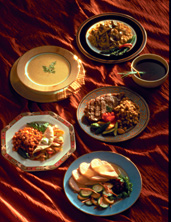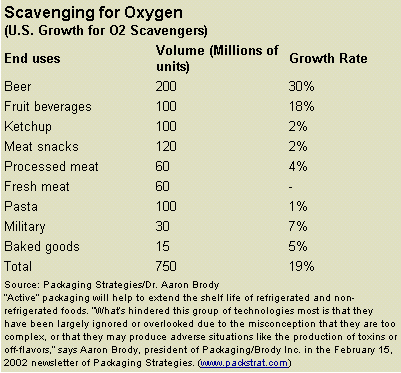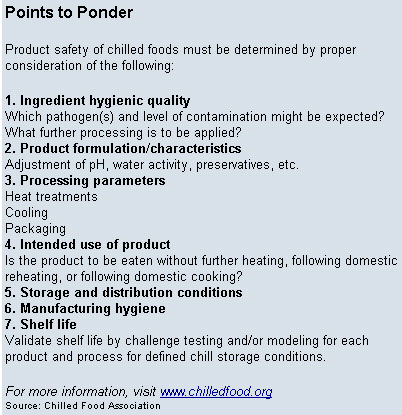
In the U.S., supermarket sales of prepared refrigerated foods reached $9.5 billion in 2001, according to Food Spectrum, Martinsville, N.J., a consulting and research organization. The company anticipates growth to over $12 billion by 2005.
“Much of the growth in this market can be attributed to prepared component products that significantly reduce meal preparation times,” says Casey Roberts, vice president of market research, Food Spectrum. “We see more retail products that offer a unique point of difference by integrating refrigerated components that help consumers prepare fresh, home-made meals in a fraction of the time.”
Shelf life of refrigerated foods varies with the product. Whether you are targeting a shelf life of three days or three weeks, effective formulation hurdles, proper testing and new technologies will help create safe refrigerated foods that deliver convenience and freshness.
Hurdle Effect
“It is essential that “hurdle” technologies be utilized, as we cannot rely exclusively on the maintenance of refrigerated conditions to assure the safety of perishable foods,” states Lou Cooperhouse, president and CEO, Food Spectrum. Formulation hurdles include acidulants, water activity Aw control, antioxidants, blanching and the incorporation of antimicrobial agents.“If the Aw is below 0.92, Listeria monocytogenes, which is the pathogen of primary concern at refrigeration temperatures, cannot grow. Spoilage pseudomonads have a minimal (Aw) requirement of around 0.97, so formulations with Aw below that will have fewer spoilage organisms,” says Ellen Vestergaard, research manager, Silliker Laboratories, South Holland, Ill. “A pH below 4.4 inhibits the growth of Listeria, ensuring the safety of the product. Lowering the pH, storage temperature and initial microbial load will also result in longer shelf lives.”
Packaging under vacuum or modified atmospheres limits the growth of fast-growing aerobic bacteria such as Pseudomonas as well as mold. Modified atmosphere packaging (MAP) is used in a variety of products, such as raw, value-added proteins (meat, fish), fresh pasta, prepared entrees, bagged salads, fresh-cut fruits and cooked sliced meats. This technique is practiced more in the U.S. than the in the U. K. (See “Scavenging for Oxygen” chart.)

Combining these factors often creates a synergistic effect in foods. This can be seen in the following examples. “In salad dressings and some salsas and sauces, acetic acid in vinegar is the primary antimicrobial,” explains Vestergaard. The addition of salts and sugars lowers water activity. “Processors can use irradiated spices to limit initial microbial load. Using vegetable washes, soaking fresh ingredients in vinegar or cooking them prior to use decreases microbial counts, as well.”
In meats, vacuum-packaging or modified atmosphere inhibit fast-growing aerobic organisms. “For ready-to-eat meat products, validated heat processes ensure that heating kills Listeria and reduces spoilage organisms. Good sanitation limits the potential for post-processing contamination. Low storage temperature also extends shelf-life,” Vestergaard adds.

Key Technologies
In addition to formulation challenges, Cooperhouse adds that there are packaging hurdles as well as thermal and non-thermal processing considerations. Thermal processing issues include processes that heat product either before or after it has been packaged, and include cook-chill, sous vide and microwave pasteurization. “Among thermal processing hurdles, we expect to see a reemergence of sous vide post-pasteurization as a technology solution for value-added meat and poultry products, and a variety of other applications,” he observes.Non-thermal processing hurdles include ultra-high pressure processing, irradiation and pulsed light, and pulsed electric field technology. “We believe that ultra-high pressure processing will be utilized in an expanded range of products in coming years,” says Cooperhouse. “The fresh beverage segment has quickly embraced this technology, as it more than doubles shelf life with almost no degradation in fresh quality.”
“It is also believed that irradiation, now utilized in a number of fresh ground beef applications, will be utilized in an expanded range of products in coming years; however, the potential for this technology will only be realized if current labeling requirements are relaxed,” he adds.
Ensuring Safety
After establishing effective hurdles in refrigerated foods, proper testing needs to confirm the product's safety and shelf life. “Shelf-life studies are recommended for products with neutral pH and high water activity such as meats, vegetables, fish and poultry,” explains Vestergaard.Challenge studies for shelf-life stability should be used for products with lower pH or water activity to determine if accidental contamination with lactic acid bacteria (which grow in low pH and high water activity), yeast, or mold can lead to spoilage.
Vestergaard also recommends challenge studies with Listeria for refrigerated products with a pH of 4.4 or above, and water activity of 0.92 or above. “It is also critical to conduct a challenge study with multi-component foods due to uncertainty of Listeria growth at different interfaces.”
Food Spectrum, LLC, has published Retail Prepared Refrigerated Foods: The Market and Technologies. This report discusses process and packaging technologies driving new and established products in supermarket produce, deli, and meat departments. It offers market size estimates, forecasts, and market shares held by major competitors, as well as an analysis of trends affecting the market and each of its categories. For more information on the complete report, category-specific mini-studies, or a separate study on refrigerated food technologies, call 1-877-FOOD888, or visit www.foodspectrum.com